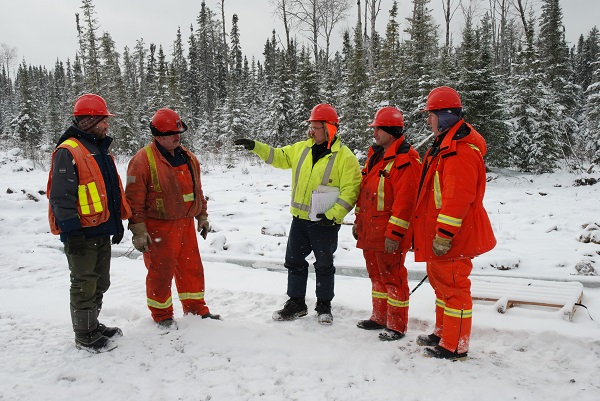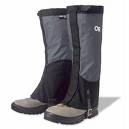
Avoid cotton and goose down to help prevent hypothermia
In Ontario, working outside during the Canadian winter can leave workers susceptible to illnesses like hypothermia or injuries from frostbite. Hypothermia happens when the body’s core temperature drops below what is required for normal metabolism and body functions.
“Due to the long-term effects and potential fatalities of cold injury, there are a few things we can do to support ourselves and those who work outdoors,” says Lindsay Digby, Health and Safety Specialist at Workplace Safety North. “Not only do you need to stay warm and dry to prevent hypothermia during outdoor work, it’s also important to eat properly, stay active, and keep an eye on each other.
“If you know a worker who's new to the region and may be unaccustomed to colder weather, it’s important to stress these simple points, especially being prepared and dressing for the weather,” adds Digby.
Dress the part: Avoid cotton and goose down
While working outdoors, things like heaters and warming huts are not always available, so winter clothing becomes your critical control and the single most important resource to keep warm. It’s essential to dress in loose-fitting layers, which trap heat easily and allow you to adjust clothing as your activities change throughout the day. If overdressed, you’ll work up a sweat as the day progresses.
When you’re less active, sweat starts to cool your body down, so it’s important to wear enough layers to keep warm, but not so hot as to sweat excessively. If you are sweating profusely, you may be overexerting yourself; work activities and hydration should be adjusted accordingly. Be sure to add layers of clothing as your activity level decreases. Layers should be made of fabrics that retain warmth when wet such as wool, polyester fleece, and polypropylene (often found in synthetic long underwear).
Cotton is quite possibly the worst fabric to wear for warmth in winter. Once it gets wet from rain, snow or sweat, the cotton will start to extract heat out of the body. The effects are especially noticeable in cotton socks, underwear, or if a cotton T-shirt is the first layer next to skin. Goose down is an excellent insulator when dry, but because it loses almost all its insulating power when wet, it is best to avoid during winter months.
Layering Systems
To work comfortably outside, a layering system should be applied to pants, socks, jackets, gloves and hats. It starts with a wicking layer to remove moisture from skin. From there it builds into heavier and more durable fabric to keep you warm.
Wicking Layer: This is the layer next to your skin. To avoid your body cooling down due to sweat, this layer should remove moisture from the skin and transfer it to the next layer. Recommended layers are synthetic or polypropylene long underwear, tops, and socks – no cotton!
Light Insulating Layer: This goes on after the wicking layer. A light fleece or thin wool sweater is an excellent light insulating layer.
Heavy Insulating Layer: A heavier fleece or wool sweater begins to trap heat in the body.
Windproof-Waterproof Layer: This protects your body from a variety of weather conditions, from wind to rain or wet snow.
Winter Toque: Thirty to 50 per cent of body heat is lost through the head. A winter hat adds as much warmth as all your layers. In winter conditions, everyone should be wearing a toque. Balaclavas can be worn under toques and are excellent for protecting facial tissue from frostnip or frostbite, particularly if hard hats are mandatory in extreme cold conditions and you’re working outdoors in the open.
|
|
Gloves and Mitts: Mitts are warmer than gloves but not always practical for work that requires detail. To help with this problem, a thin glove can be worn inside a mitt. This will allow you to remove your mitts for more technical work while not exposing bare skin to the cold. Once work is completed, return your gloved hands promptly to your mitts. Also, mitts with separate index finger are very useful for certain applications. Having an extra pair of mitts will also allow you to switch them out and continue working if they become excessively damp.
Socks and Gaiters: A two-layer sock system is most recommended for winter travel. A thin polypropylene sock with a wool sock over top allows moisture to be wicked from the feet and wool will stay warm even when wet. Boot size is also important – your toes need wiggle room – avoid a tight fit that restricts circulation. Some workers prefer a single pair of loose-fitting wool and/or synthetic material socks in an insulated boot, and bring a spare pair just in case.
If wearing hiking boots in the bush, gaiters are highly recommended. They prevent snow from sliding down into the boots and add warmth by trapping air. Gaiters go on the outside of the boot and pant leg and are great for keeping snow from entering boots
Fuel your body: Go ahead and eat up!
Working outdoors requires your body to produce heat to keep you warm. Due to the extreme conditions, it’s best to take in your calories steadily over the day. Six to eight snacks are far better than two heavy meals. Fifty per cent of your nutritional intake should be from carbohydrates such as bread and bagels. Cheese, butter, and meats add a valuable fat content to help keep your body warm, and things like nuts, jerky, and dried fruit are quick and easy-to-carry items for that snack along the way.
Avoid caffeine and alcohol
Hydration is very important for winter work. On average, you should drink about four litres of water or fluids a day. If you only have a one-litre water bottle with you during the day, make sure to consume lots of hot drinks at breakfast and dinner. Drinks with caffeine (coffee or soda) or alcohol should be avoided.
Caffeine and alcohol restrict blood vessels, impeding the body’s ability to heat itself. In the cold, water bottles will need to be insulated to prevent freezing. Cold air is dryer than warm air and we can easily lose two quarts of water an hour during strenuous activity. You may want to consider a product such as ‘Vitalyte’ as part of an emergency kit to fight off dehydration and help prevent hypothermia.
Consuming appropriate liquids is very important, but just as important is removing excess liquids from your body. Our bodies will use valuable energy to warm areas of the body up, and when liquids remain in our system, energy is lost trying to keep that liquid warm. Regular restroom breaks throughout the day are highly recommended to ensure that the valuable energy is being distributed to all extremities.
The buddy system: Check for signs of hypothermia
“If someone in your group has voiced concern about being cold, or has begun shivering, they have mild hypothermia,” says Digby. “Hypothermia is easiest to treat at this stage, so you should immediately take steps towards a warm drink, warm food and staying active, and changing out any clothing that has become excessively dampened–-all of which are quick sources of treatment. A hot drink or meal can do a lot to add heat to the body. As well, an extra layer and a hat or balaclava can help prevent more heat from leaving the body.
“Keeping an eye on each other is not only the key workplace safety concept behind the Internal Responsibility System,” says Digby, “it’s the best way to ensure that mild cases of hypothermia are prevented and don’t have the chance to progress to moderate or severe hypothermia.” For those with moderate hypothermia, minimizing movement is recommended along with heating blankets and a warming location preferably indoors. Severe hypothermia can include confusion, lethargy, slurred speech, and loss of consciousness, and your emergency response plan should be followed to prevent further harm or loss.
“Working outdoors in the wintertime can be a great experience,” says Digby, “if you’re dressed properly, have adequate food and liquids, and keep an eye on your team members. Never travel and work on your own unless someone knows your route and estimated time of return. And when travelling as a group via snowmobile or ATV be sure to use the buddy system.”
Even if you are only heading out for a few hours, the proper emergency preparedness and equipment is still essential.
Related
Is there a temperature at which work becomes dangerous and should be stopped? - Canadian Centre of Occupational Health and Safety
White out! Winter driving tips – on and off the job - Workplace Safety North
Winter Driving - Safety Meeting Talk - WSN
Working in the Cold - infographic CCOHS
Safety at work - Physical Exposures - Cold stress/hypothermia - WorkSafeBC
Be prepared for winter weather – Environment Canada
Ice Roads – Best Practices for Building and Working Safely on Ice Covers in Ontario – Ministry of Labour, Infrastructure Health and Safety Association



